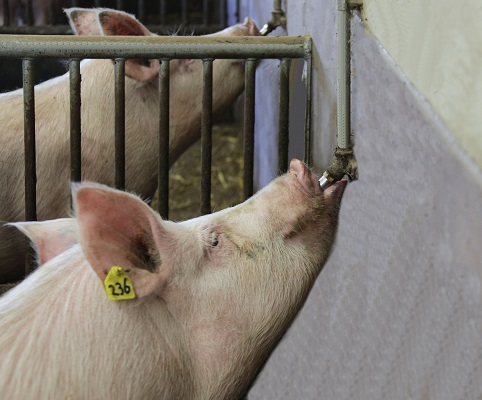

When moved to the weaning facility, one of the first things a pig should do is look for water and take a drink. Unfortunately, the stress of movement, new surroundings and new penmates can delay adequate hydration. Without prevention or support, this dehydration can delay performance and cause significant setbacks in young pigs.
Dehydration is one of the largest challenges young pigs face at weaning. A lack of water consumption is clear when looking at the numbers. In fact, estimates show only 51 percent of newly weaned pigs consume water in the first 25 hours post-weaning.
The young pig is made up of about 70 percent water, so keeping him hydrated is very important in getting him started. At weaning, we need to do everything we can to get pigs drinking and eating. Feed intake the first few days post-weaning is highly correlated to water intake. The faster we get them eating and drinking, the better the performance is going to be in that first 40 days post-weaning – and beyond. Following are three tips to help keep pigs hydrated pre- and post-weaning to set the stage for a successful finish.
Provide adequate water space and flow
A target water consumption for weaned pigs is 0.3 gallons of water per pound of feed consumed, equating to 0.7 gallons of water per day throughout the weaning period. To allow pigs adequate access to water, provide one waterer for every 10 pigs. Test the water quality, temperature and flow rate prior to introducing pigs to the facility.
You need to provide plenty of water space and plenty of water availability.
Provide support at weaning
Due to new surroundings, penmates and transport, stressed pigs will often drink low amounts of water during the weaning transition. Hydration support can help minimize the stress by providing essential nutrients and lessen performance lag during the transition.
Electrolyte solutions and gel can help keep pigs hydrated and performing well in that first week post-weaning. Look for a product that provides sodium, chloride, magnesium, vitamins and pH acidifiers. These nutrients help balance the gut and keep the pig drinking and eating.
Provide support through challenges
Dehydration is also likely during health challenges or other times of stress. Critical times in the pig production cycle include: transport, disease and vaccination.
A sign of stress in pigs is diarrhea. If a pig has diarrhea, he’s losing electrolytes and the water balance in the pigs can reach critical levels. This imbalance can damage the villi in the pig’s digestive tract, resulting in decreased nutrient absorption long-term.
Gels and electrolytes work well when pigs have diarrhea, because of the added nutrients they provide. These tools are a very good adjunct to help pigs through challenges and help set them up for long-term performance. Through all phases, hydration is critical. Keep pigs hydrated by adding electrolytes to their water.
 Contact Jaguza Support
Contact Jaguza Support